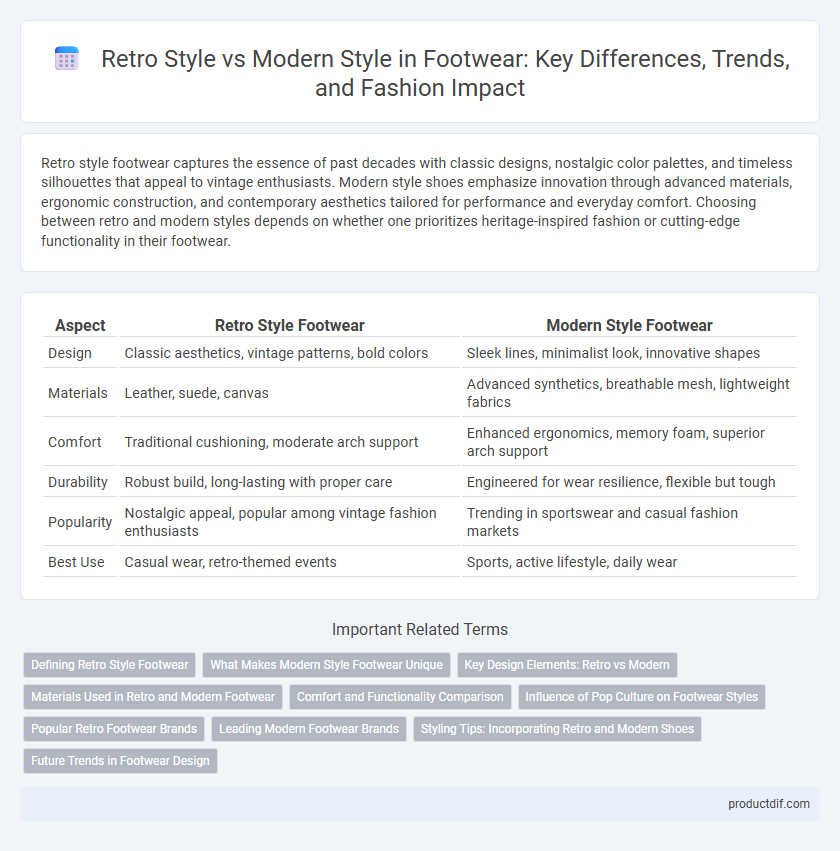Retro style footwear captures the essence of past decades with classic designs, nostalgic color palettes, and timeless silhouettes that appeal to vintage enthusiasts. Modern style shoes emphasize innovation through advanced materials, ergonomic construction, and contemporary aesthetics tailored for performance and everyday comfort. Choosing between retro and modern styles depends on whether one prioritizes heritage-inspired fashion or cutting-edge functionality in their footwear.
Table of Comparison
| Aspect | Retro Style Footwear | Modern Style Footwear |
|---|---|---|
| Design | Classic aesthetics, vintage patterns, bold colors | Sleek lines, minimalist look, innovative shapes |
| Materials | Leather, suede, canvas | Advanced synthetics, breathable mesh, lightweight fabrics |
| Comfort | Traditional cushioning, moderate arch support | Enhanced ergonomics, memory foam, superior arch support |
| Durability | Robust build, long-lasting with proper care | Engineered for wear resilience, flexible but tough |
| Popularity | Nostalgic appeal, popular among vintage fashion enthusiasts | Trending in sportswear and casual fashion markets |
| Best Use | Casual wear, retro-themed events | Sports, active lifestyle, daily wear |
Defining Retro Style Footwear
Retro style footwear emphasizes nostalgic design elements from past decades, often featuring bold colors, classic silhouettes, and vintage materials like suede and leather. These shoes prioritize authenticity and craftsmanship to evoke a timeless appeal, frequently inspired by iconic models from the 70s, 80s, and 90s. In contrast to modern style's minimalist and tech-driven approach, retro shoes highlight detailed stitching, thicker soles, and heritage branding that celebrate footwear history.
What Makes Modern Style Footwear Unique
Modern style footwear stands out due to its emphasis on advanced materials such as breathable mesh, lightweight synthetics, and responsive foam cushioning, which provide enhanced comfort and performance. Innovative design elements like seamless construction and ergonomic shapes contribute to better fit and functionality tailored for active lifestyles. Integration of technology, including smart insoles and sustainable manufacturing processes, defines the distinctiveness of contemporary shoe styles compared to retro models.
Key Design Elements: Retro vs Modern
Retro footwear design features classic materials like suede and canvas with bold color blocking, thick soles, and prominent branding inspired by vintage athletic shoes. Modern footwear emphasizes lightweight, breathable fabrics such as mesh and knit, streamlined silhouettes, minimalist detailing, and advanced cushioning technologies like foam and air units. The contrast between retro and modern styles lies in the balance between nostalgic aesthetics and performance-driven innovation in materials and form.
Materials Used in Retro and Modern Footwear
Retro footwear often features natural materials like leather, canvas, and rubber, emphasizing durability and classic aesthetics. Modern footwear incorporates advanced synthetics such as engineered mesh, EVA foam, and TPU, enhancing breathability, lightweight comfort, and performance. Innovations in materials technology drive a clear distinction between the traditional, robust construction of retro shoes and the high-tech functionality of modern designs.
Comfort and Functionality Comparison
Retro style footwear often features classic designs with minimal cushioning and traditional materials, which may limit comfort during extended wear. Modern style shoes incorporate advanced technologies like memory foam insoles and breathable mesh uppers, significantly improving comfort and breathability. Functionality in modern footwear extends to enhanced support and shock absorption, making them better suited for active lifestyles compared to retro models.
Influence of Pop Culture on Footwear Styles
Pop culture significantly shapes footwear trends, with retro styles often drawing inspiration from iconic 80s and 90s music, movies, and sports figures, blending nostalgia with contemporary flair. Modern styles embrace futuristic designs influenced by technology, social media, and urban streetwear, emphasizing innovation and self-expression. Iconic sneakers like the Air Jordan and Adidas Superstar exemplify how pop culture icons drive both retro revivals and modern adaptations in footwear.
Popular Retro Footwear Brands
Popular retro footwear brands like Converse, Vans, and Adidas Stan Smiths have maintained their classic designs while appealing to vintage fashion enthusiasts. These brands emphasize heritage craftsmanship and iconic silhouettes, distinguishing them from modern styles that prioritize advanced materials and technology. Retro sneakers continue to thrive in streetwear culture, blending timeless aesthetics with contemporary urban trends.
Leading Modern Footwear Brands
Leading modern footwear brands, such as Nike, Adidas, and Puma, emphasize cutting-edge technology, innovative materials, and performance-driven designs that cater to athletes and style-conscious consumers alike. These brands integrate sustainable practices and smart features, including lightweight cushioning and advanced support systems, setting them apart from retro-style shoes characterized by classic designs and nostalgic appeal. The modern style prioritizes functionality and futuristic aesthetics, driving market trends and consumer preferences in contemporary footwear.
Styling Tips: Incorporating Retro and Modern Shoes
Retro-style footwear adds a nostalgic vibe with bold colors and classic silhouettes, ideal for pairing with vintage-inspired outfits like high-waisted jeans and graphic tees. Modern shoes emphasize sleek designs and innovative materials, complementing minimalist and athleisure looks that highlight clean lines and comfort. Combining retro and modern styles involves balancing statement sneakers with contemporary clothing pieces to create a unique, fashion-forward ensemble.
Future Trends in Footwear Design
Retro style footwear continues to influence future trends with its nostalgic appeal and classic silhouettes, driving demand for vintage-inspired materials and colorways. Modern style emphasizes innovation through advanced materials like sustainable fabrics and 3D-printed components, prioritizing functionality and comfort. The convergence of retro aesthetics with cutting-edge technology is expected to dominate upcoming footwear designs, balancing heritage with futuristic performance features.
Retro style vs Modern style Infographic

 productdif.com
productdif.com